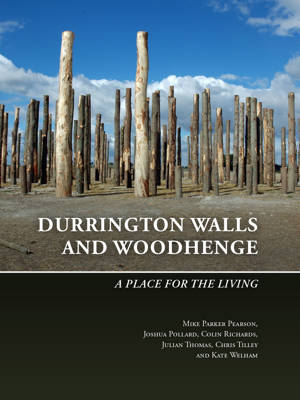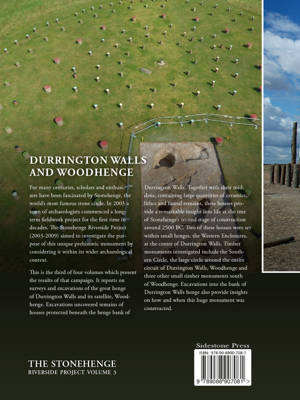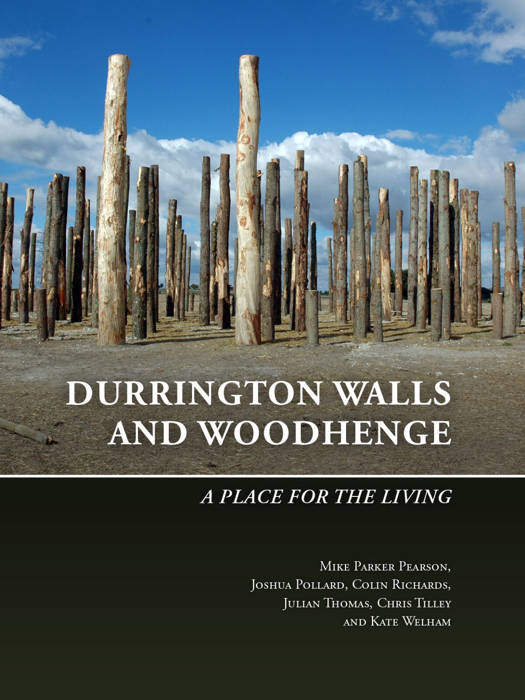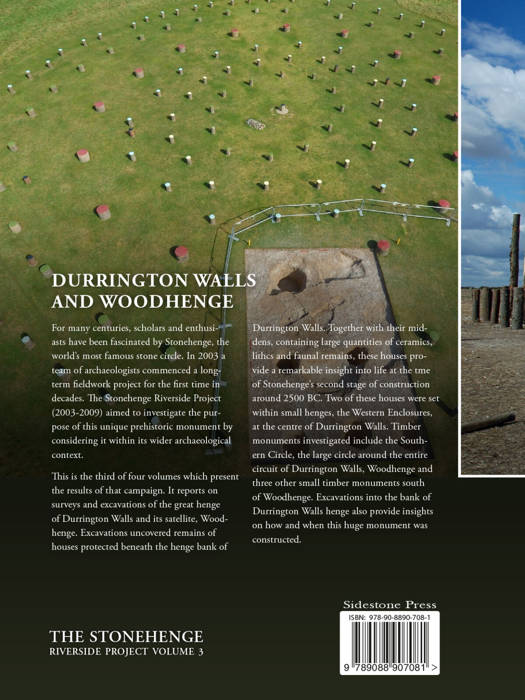
En raison d'une grêve chez bpost, votre commande pourrait être retardée. Vous avez besoin d’un livre rapidement ? Nos magasins vous accueillent à bras ouverts !
- Retrait gratuit dans votre magasin Club
- 7.000.000 titres dans notre catalogue
- Payer en toute sécurité
- Toujours un magasin près de chez vous
En raison de la grêve chez bpost, votre commande pourrait être retardée. Vous avez besoin d’un livre rapidement ? Nos magasins vous accueillent à bras ouverts !
- Retrait gratuit dans votre magasin Club
- 7.000.0000 titres dans notre catalogue
- Payer en toute sécurité
- Toujours un magasin près de chez vous


Durrington Walls and Woodhenge
A place for the living
Mike Parker Pearson, Joshua Pollard, Colin Richards, Julian Thomas
49,95 €
+ 99 points
Format
Description
For many centuries, scholars and enthusiasts have been fascinated by Stonehenge, the world's most famous stone circle. In 2003 a team of archaeologists commenced a long-term fieldwork project for the first time in decades. The Stonehenge Riverside Project (2003-2009) aimed to investigate the purpose of this unique prehistoric monument by considering it within its wider archaeological context.
This is the third of four volumes which present the results of that campaign. It reports on surveys and excavations of the great henge of Durrington Walls and its satellite, Woodhenge. Excavations uncovered remains of houses protected beneath the henge bank of Durrington Walls. Together with their middens, containing large quantities of ceramics, lithcs and faunal remains, these houses provide a remarkable insight into life at the tme of Stonehenge's second stage of construction around 2500 BC. Two of these houses were set within small henges, the Western Enclosures, at the centre of Durrington Walls. Timber monuments investigated include the Southern Circle, the large circle around the entire circuit of Durrington Walls, Woodhenge and three other small timber monuments south of Woodhenge. Excavations into the bank of Durrington Walls henge also provide insights on how and when this huge monument was constructed.
With contributions by:
Umberto Albarella, Wayne Bennett, Andrew Chamberlain, Ben Chan, Henry Chapman, Ros Cleal, Oliver Craig, Glyn Davies, Roger Doonan, Jane Evans, Charly French, Chris Gaffney, Vince Gaffney, Paul Garwood, Barney Harris, Rob Ixer, Mandy Jay, Chris Knüsel, Neil Linford, Richard Madgwick, Pete Marshall, Claudia Minnitti, Wolfgang Neubauer, Bob Nunn, Andy Payne, Derek Pitman, Dave Robinson, Clive Ruggles, Jim Rylatt, Lisa-Marie Shillito, Ellen Simmons, Anne Teather, Alan Vince†, Sarah Viner-Daniels and Christie Willis
Contents:
LIST OF FIGURES
LIST OF TABLES
CONTRIBUTORS
PREFACE
ACKNOWLEDGEMENTS
1. Durrington Walls in the landscape
Henges in the Stonehenge landscape - (C. Tilley and W. Bennett)
Geophysical survey - (K. Welham with C. Gaffney, N. Linford & A. Payne)
The pre-henge buried soil in Trench 6, Durrington Walls - (C. French)
2. The village
Houses and middens - (M. Parker Pearson et al.)
Pit groups - (M. Parker Pearson et al.)
Houses within the western enclosures - (J. Thomas)
Overview of occupation around and beneath the henge earthworks - (M. Parker Pearson et al.)
3. Representations of the house
The Southern Circle - (J. Thomas)
The Southern Circle's plan - (M. Parker Pearson, J. Pollard & C. Richards)
The Southern Circle's sequence - (M. Parker Pearson and C. Richards)
The Southern Circle's significance - (J. Thomas)
The Durrington Walls Avenue - (M. Parker Pearson et al.)
Woodhenge - (J. Pollard & D. Robinson)
South of Woodhenge - (J. Pollard & D. Robinson)
Timber monuments and beyond - (J. Pollard, C. Ruggles et al.)
4. Enclosure and commemoration
The line of postholes in Zone 5 - (M. Parker Pearson)
The timber circle - (M. Parker Pearson, H. Chapman, V. Gaffney, P. Garwood, W. Neubauer and J. Pollard)
The henge bank - (M. Parker Pearson)
Henge enclosures within Durrington Walls - (J. Thomas)
The south and west sides of Durrington Walls - (R. Nunn, J. Rylatt & M. Parker Pearson)
Woodhenge cove - (J. Pollard & D. Robinson)
5. Radiocarbon dating
P. Marshall
6. Pottery
Grooved Ware and Beaker pottery - (R. Cleal)
Ceramic petrology - (R. Ixer & A. Vince)
7. Lithics and sarsen-working
Stone artefacts - (B. Chan)
8. Worked bone and antler artefacts
G. Davies
9. Chalk-working
Chalk-working - (B. Harris)
Carved chalk objects - (A. Teather)
10. Faunal remains
Durrington Walls - (U. Albarella & S. Viner)
South of Woodhenge - (C. Minnitti, U. Albarella & S. Viner-Daniels)
11. Human bones
A. Chamberlain, C. Willis & C. Knüsel
12. Plant remains and wood charcoal
Carbonised plant remains - (E. Simmons)
Wood charcoal - (E. Simmons)
13. Lipid analysis of ceramics
O. Craig & L.-M. Shillito
14. Isotopic analyses
Stable isotopes - (M. Jay)
Strontium and oxygen isotopes: cattle and pig mobility and seasonality - (J. Evans, R. Madgwick, S. Viner & U.Albarella)
15. The life and times of Durrington Walls
Households, deposition and social space - (M. Parker Pearson, B. Chan et al.)
Soil micromorphology of house floors and middens - (C. French)
Spatial patterning of artefacts, burnt flint, animal bones, plant remains - (B. Chan et al.)
Geochemical and geophysical analyses - (R. Doonan and D. Pitman)
Overview - (M. Parker Pearson et al.)
This is the third of four volumes which present the results of that campaign. It reports on surveys and excavations of the great henge of Durrington Walls and its satellite, Woodhenge. Excavations uncovered remains of houses protected beneath the henge bank of Durrington Walls. Together with their middens, containing large quantities of ceramics, lithcs and faunal remains, these houses provide a remarkable insight into life at the tme of Stonehenge's second stage of construction around 2500 BC. Two of these houses were set within small henges, the Western Enclosures, at the centre of Durrington Walls. Timber monuments investigated include the Southern Circle, the large circle around the entire circuit of Durrington Walls, Woodhenge and three other small timber monuments south of Woodhenge. Excavations into the bank of Durrington Walls henge also provide insights on how and when this huge monument was constructed.
With contributions by:
Umberto Albarella, Wayne Bennett, Andrew Chamberlain, Ben Chan, Henry Chapman, Ros Cleal, Oliver Craig, Glyn Davies, Roger Doonan, Jane Evans, Charly French, Chris Gaffney, Vince Gaffney, Paul Garwood, Barney Harris, Rob Ixer, Mandy Jay, Chris Knüsel, Neil Linford, Richard Madgwick, Pete Marshall, Claudia Minnitti, Wolfgang Neubauer, Bob Nunn, Andy Payne, Derek Pitman, Dave Robinson, Clive Ruggles, Jim Rylatt, Lisa-Marie Shillito, Ellen Simmons, Anne Teather, Alan Vince†, Sarah Viner-Daniels and Christie Willis
Contents:
LIST OF FIGURES
LIST OF TABLES
CONTRIBUTORS
PREFACE
ACKNOWLEDGEMENTS
1. Durrington Walls in the landscape
Henges in the Stonehenge landscape - (C. Tilley and W. Bennett)
Geophysical survey - (K. Welham with C. Gaffney, N. Linford & A. Payne)
The pre-henge buried soil in Trench 6, Durrington Walls - (C. French)
2. The village
Houses and middens - (M. Parker Pearson et al.)
Pit groups - (M. Parker Pearson et al.)
Houses within the western enclosures - (J. Thomas)
Overview of occupation around and beneath the henge earthworks - (M. Parker Pearson et al.)
3. Representations of the house
The Southern Circle - (J. Thomas)
The Southern Circle's plan - (M. Parker Pearson, J. Pollard & C. Richards)
The Southern Circle's sequence - (M. Parker Pearson and C. Richards)
The Southern Circle's significance - (J. Thomas)
The Durrington Walls Avenue - (M. Parker Pearson et al.)
Woodhenge - (J. Pollard & D. Robinson)
South of Woodhenge - (J. Pollard & D. Robinson)
Timber monuments and beyond - (J. Pollard, C. Ruggles et al.)
4. Enclosure and commemoration
The line of postholes in Zone 5 - (M. Parker Pearson)
The timber circle - (M. Parker Pearson, H. Chapman, V. Gaffney, P. Garwood, W. Neubauer and J. Pollard)
The henge bank - (M. Parker Pearson)
Henge enclosures within Durrington Walls - (J. Thomas)
The south and west sides of Durrington Walls - (R. Nunn, J. Rylatt & M. Parker Pearson)
Woodhenge cove - (J. Pollard & D. Robinson)
5. Radiocarbon dating
P. Marshall
6. Pottery
Grooved Ware and Beaker pottery - (R. Cleal)
Ceramic petrology - (R. Ixer & A. Vince)
7. Lithics and sarsen-working
Stone artefacts - (B. Chan)
8. Worked bone and antler artefacts
G. Davies
9. Chalk-working
Chalk-working - (B. Harris)
Carved chalk objects - (A. Teather)
10. Faunal remains
Durrington Walls - (U. Albarella & S. Viner)
South of Woodhenge - (C. Minnitti, U. Albarella & S. Viner-Daniels)
11. Human bones
A. Chamberlain, C. Willis & C. Knüsel
12. Plant remains and wood charcoal
Carbonised plant remains - (E. Simmons)
Wood charcoal - (E. Simmons)
13. Lipid analysis of ceramics
O. Craig & L.-M. Shillito
14. Isotopic analyses
Stable isotopes - (M. Jay)
Strontium and oxygen isotopes: cattle and pig mobility and seasonality - (J. Evans, R. Madgwick, S. Viner & U.Albarella)
15. The life and times of Durrington Walls
Households, deposition and social space - (M. Parker Pearson, B. Chan et al.)
Soil micromorphology of house floors and middens - (C. French)
Spatial patterning of artefacts, burnt flint, animal bones, plant remains - (B. Chan et al.)
Geochemical and geophysical analyses - (R. Doonan and D. Pitman)
Overview - (M. Parker Pearson et al.)
Spécifications
Parties prenantes
- Auteur(s) :
- Editeur:
Contenu
- Nombre de pages :
- 430
- Langue:
- Anglais
- Collection :
- Tome:
- n° 3
- Illustré:
- Oui
Caractéristiques
- EAN:
- 9789088907081
- Date de parution :
- 14-03-25
- Format:
- Livre broché

Les avis
Nous publions uniquement les avis qui respectent les conditions requises. Consultez nos conditions pour les avis.







